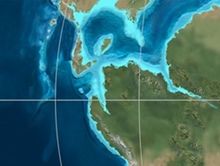El Peñón Formation
| El Peñón Formation Stratigraphic range: Late Aptian ~ | |
|---|---|
| Type | Geological formation |
| Unit of | Villeta Group |
| Underlies | Capotes Formation |
| Overlies | Trincheras Formation |
| Thickness | more than 381 m (1,250 ft) |
| Lithology | |
| Primary | Calcareous shale |
| Other | Siltstone, gypsum |
| Location | |
| Coordinates | 5°15′13″N 74°20′28″W / 5.25361°N 74.34111°WCoordinates: 5°15′13″N 74°20′28″W / 5.25361°N 74.34111°W |
| Region | Altiplano Cundiboyacense Eastern Ranges, Andes |
| Country | |
| Type section | |
| Named for | El Peñón |
| Named by | Ulloa |
| Location | El Peñón |
| Year defined | 1982 |
| Coordinates | 5°15′13″N 74°20′28″W / 5.25361°N 74.34111°W |
| Region | Cundinamarca |
| Country | |
| Thickness at type section | 381 m (1,250 ft) |
 Paleogeography of Northern South America 120 Ma, by Ron Blakey | |
The El Peñón Formation (Spanish: Formación El Peñón, Kipe) is a geological formation of the Altiplano Cundiboyacense, Eastern Ranges of the Colombian Andes. The formation consists of calcareous shales and siltstones and dates to the Early Cretaceous period; Late Aptian epoch and has a measured thickness at its type section of 381 metres (1,250 ft). Ammonite fossils have been found in the formation, deposited in a shallow marine platform environment.
Etymology[]
The formation was defined and named in 1982 by Ulloa after El Peñón, Cundinamarca.[1]
Description[]
Lithologies[]
The El Peñón Formation has at is type section a thickness of 381 metres (1,250 ft),[2] and is characterised by a sequence of calcareous shales and siltstones. The middle part of the sequence contains gypsum.[3] Fossils of the ammonites and have been found in the El Peñón Formation.[1]
Stratigraphy and depositional environment[]
The El Peñón Formation, part of the Villeta Group, conformably overlies the Trincheras Formation and is conformably overlain by the Capotes Formation.[4] The age has been estimated to be Late Aptian.[1] Stratigraphically, the formation is time equivalent with the and a lateral facies equivalent of the Socotá Formation.[5] The formation has been deposited in a shallow marine platform environment.[1] In the Late Aptian, central Colombia was dominated by shallow marine carbonate platform environments.[6]
Outcrops[]

The El Peñón Formation, restricted to Cundinamarca, is locally found around its type locality,[1] between Bituima and Guayabal de Síquima,[7] and along the road from Villeta to Sasaima.[2]
Regional correlations[]
| Age | Paleomap | VMM | Guaduas-Vélez | W Emerald Belt | Villeta anticlinal | Chiquinquirá- Arcabuco |
Tunja- Duitama |
Altiplano Cundiboyacense | El Cocuy | ||||
|---|---|---|---|---|---|---|---|---|---|---|---|---|---|
| Maastrichtian |  |
eroded | Guaduas | ||||||||||
| Guadalupe | |||||||||||||
| Campanian | |||||||||||||
| Oliní | |||||||||||||
| Santonian | - | ||||||||||||
| Coniacian | Oliní | Conejo | Chipaque | ||||||||||
| Loma Gorda | undefined | La Frontera | |||||||||||
| Turonian |  |
Hondita | La Frontera | ||||||||||
| Cenomanian | hiatus | Simijaca | |||||||||||
| Pacho Fm. | Hiló - Pacho | Une | |||||||||||
| Albian |  |
Hiló | Une | ||||||||||
| Capotes - - | |||||||||||||
| Aptian | Capotes | Socotá - El Peñón | Paja | Fómeque | |||||||||
| Paja | Paja | El Peñón | Trincheras | ||||||||||
| La Naveta | |||||||||||||
| Barremian | 
| ||||||||||||
| Hauterivian | Las Juntas | ||||||||||||
| Rosablanca | Ritoque | ||||||||||||
| Valanginian | Ritoque | - Murca | Rosablanca | hiatus | Macanal | ||||||||
| Rosablanca | |||||||||||||
| Berriasian |  |
Guavio | |||||||||||
| Arcabuco | |||||||||||||
| Sources | |||||||||||||
See also[]
 Geology of the Eastern Hills
Geology of the Eastern Hills Geology of the Ocetá Páramo
Geology of the Ocetá Páramo Geology of the Altiplano Cundiboyacense
Geology of the Altiplano Cundiboyacense
References[]
Bibliography[]
- , and . 2002. Mapa Geológico del Departamento de Cundinamarca - 1:250,000 - Memoria explicativa, 1–108. INGEOMINAS. Accessed 2017-04-26.
- , and . 2001. Geología de la Plancha 208 Villeta - 1:100,000, 1-84. INGEOMINAS. Accessed 2017-06-05.
- . 2012. Chronology Relative Sea Level History and a New Sequence Stratigraphic Model for Basinal Cretaceous Facies of Colombia, 161–216. Society for Sedimentary Geology (SEPM).
Maps[]
- , and . 1998. Plancha 208 - Villeta - 1:100,000, 1. INGEOMINAS. Accessed 2017-06-06.
- ; , and . 1998. Plancha 227 - La Mesa - 1:100,000, 1. INGEOMINAS. Accessed 2017-06-06.
External links[]
- ; ; , and . 2015. Plancha 5-09 del Atlas Geológico de Colombia 2015 – escala 1:500,000, 1. Servicio Geológico Colombiano. Accessed 2017-03-16.
- Geologic formations of Colombia
- Cretaceous Colombia
- Lower Cretaceous Series of South America
- Aptian Stage
- Shale formations
- Shallow marine deposits
- Altiplano Cundiboyacense
- Geography of Cundinamarca Department
